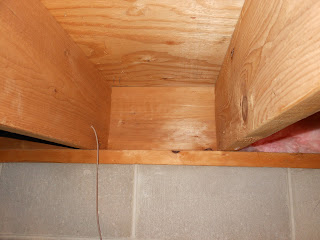 As mentioned in an earlier post, energy efficient improvements to our home are on the agenda for 2013. The work is starting in the basement where all of our existing box sills look something like this:
As mentioned in an earlier post, energy efficient improvements to our home are on the agenda for 2013. The work is starting in the basement where all of our existing box sills look something like this:As you can see, the box sills are where the wooden frame for the home connects to the concrete foundation. This part of your home is generally located above ground to avoid infestation from termites and other wood destroying insects. Because it is not insulated by the soil, the temperature in the box sills tends to fluctuate more significantly with swings in the weather. This is also a place of considerable heating or cooling losses if not insulated like the rest of the walls in your home.
Follow these simple steps to insulate your box sills successfully:
 1. Most of the floor joists in your home are probably 16 inches off of center. This means, measuring from the center of adjacent floor joists, you will have a 16 inch span. Insulation companies make rolls of insulation to specifically fit into that size of space.
1. Most of the floor joists in your home are probably 16 inches off of center. This means, measuring from the center of adjacent floor joists, you will have a 16 inch span. Insulation companies make rolls of insulation to specifically fit into that size of space. 
2. All you need to do is measure how "deep" the sill is. It is probable that your contractor used a 2 x 10 or 2 x 12 piece of lumber to construct the sill.
 3. Insulation batts (pre-cut panels of insulation) work best for this job. They usually come in 8'-9' lengths and are faced with paper which is a vapor retarder. Cut your insulation pieces in 10-12 inch intervals.
3. Insulation batts (pre-cut panels of insulation) work best for this job. They usually come in 8'-9' lengths and are faced with paper which is a vapor retarder. Cut your insulation pieces in 10-12 inch intervals. 
4. Surprisingly, it works best to lay the insulation on a hard surface (i.e. concrete floor) with the paper side down. Using a utility knife, simply cut through the insulation being sure to press hard enough to score the paper on the other side so that it separates easily.
 5. Insert the pieces into the box sills by pressing them into place. The pieces should fit snugly, particularly near the corners and edges. Try not to compress the insulation as this can affect the R-value of the insulation. R-value is a rating that indicates how much heat flow the insulation can resist.
5. Insert the pieces into the box sills by pressing them into place. The pieces should fit snugly, particularly near the corners and edges. Try not to compress the insulation as this can affect the R-value of the insulation. R-value is a rating that indicates how much heat flow the insulation can resist.Often times, the paper should be facing out, particularly in areas that will be finished with drywall. Since this space is an unfinished store room, the direction the insulation is facing is less important.
Voila! Five simple steps later, you are well on your way to completing the insulation of all the box sills in your basement. Quite honestly, it is an easy do-it-yourself project, and one that I was able to accomplish in a short afternoon. Surprisingly, my husband immediately noticed a difference in the "draftiness" of the basement. So ladies, if you want to do something nice for your husband, buy him some rolls of insulation for Valentine's Day, insulate the box sills in your home and really impress the socks off of him! (He might even voluntarily take you out for supper as a reward!) Welcome Home.





